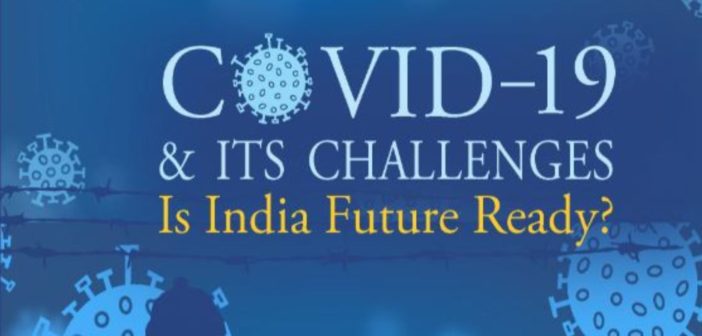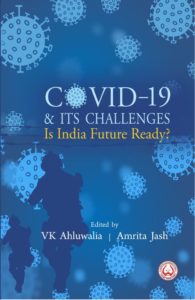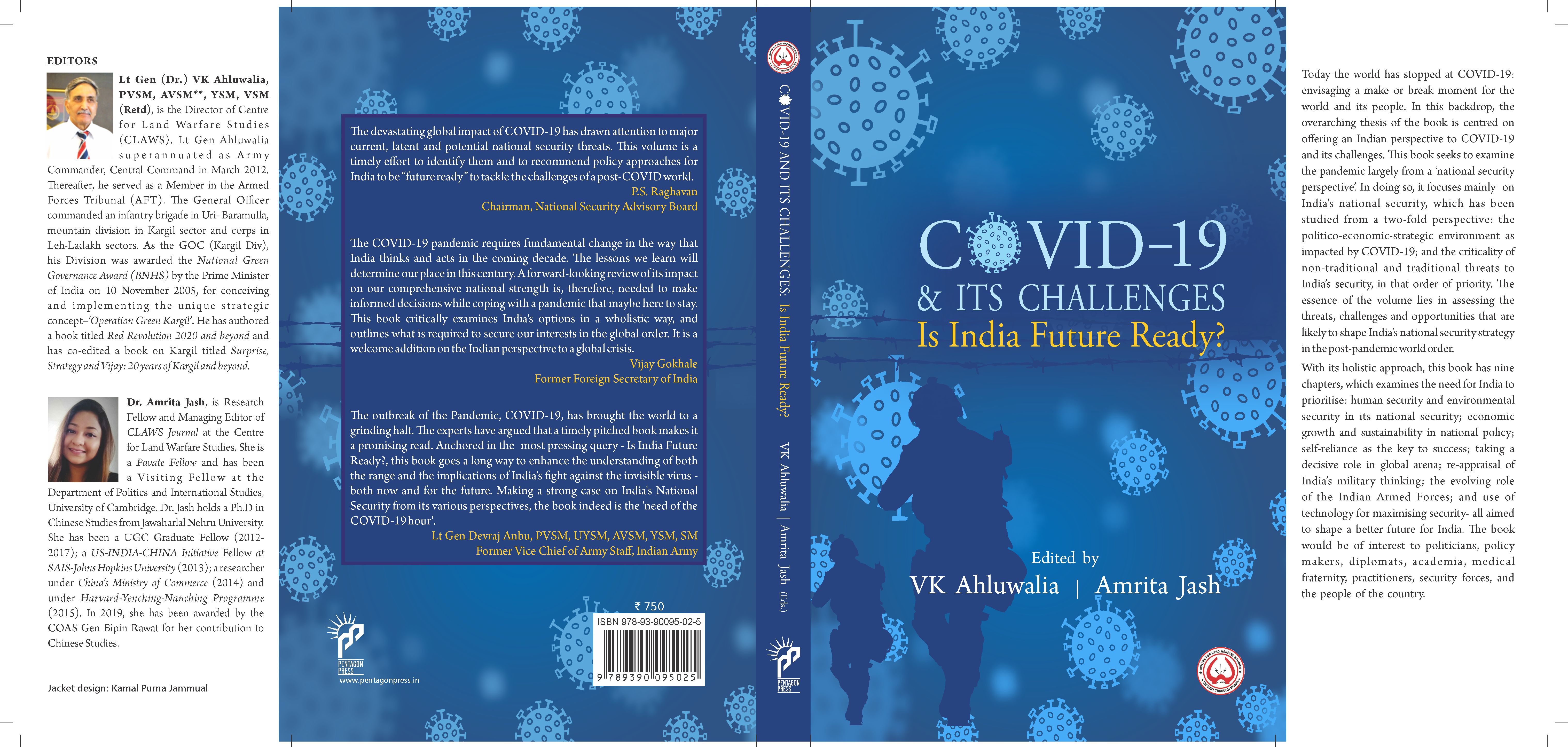
By Chris Cubbage, Executive Editor
VK Ahluwalia and Amrita Jash (eds.), COVID-19 & Its Challenges: Is India Future Ready?, New Delhi: Pentagon Press, 2020, ISBN-10 : 9390095026; ISBN-13 : 978-9390095025, E-book $9.36, Print Copy: 750 INR. PURCHASE VIA Amazon Link
Despite being amidst a dynamic start to the global pandemic – COVID-19, this work from the Centre for Land Warfare Studies (CLAWS) in New Delhi, India was born from the endeavour to publish ‘an editorial and scholarly book, based on the events that unfolded until the month of June 2020’, “as also to crystal gaze beyond the horizon and to shape a secure and brighter India.”
True to its vision, CLAWS has promptly produced deep and timely guidance for appropriate policy formulation, dealing with one of the world’s most significant events in a century and with the commensurate national security issues that a pandemic brings.
In context, with a population of 1.3 billion, India was always a country of concern as COVID-19 increasingly reached around the globe. Released in early August 2020, this publication may yet be viewed as a work in progress, as it sets the scene on how India should and will treat the pandemic and the challenges the country faces post COVID-19.
It should be noted, as at September 30, India is experiencing one of the world’s fastest growing outbreak of the virus, crossing over 6 million infections and fast approaching 100,000 dead. The issues identified by the Editors have highlighted the aspect that old methods of quarantine and isolation cannot fully cater to India. “As is obvious, the safety only accrues to the privileged while more than half of the population is forced to face the challenges of starvation, unemployment, no-cash situation compounded with the burden of lack of heath care facilities and support.”
With 11 contributors across nine chapters, culminating in ‘Making India Future Ready’ this book provides critical insight into India’s strategic challenges in 2020 and importantly, the recognition that ‘human security’ remains the preeminent domain for national security. “The security aspect needs a multi-domain approach, as non-traditional threats today pose a far greater challenge. What lies at the core, is the aspect of human security and well-being of the people. Every nation must realise that its people or human capital is its core strength. Hence, the need of the hour is to ‘realign the priorities’, such that human security takes precedence in the gamut of national security.”
General Ng Vij, former Chief of the Army Staff notes in his Foreword, “The need of the hour calls for a “Re-Think and Refining” India’s national security issues and policies in practice- both at home and abroad, it is time to push the security envelope, rather than fold it further.”
It is time for bold decisions and bold investments, and not for conservative approaches. This also is the time to move from command and control economy to plug-and-play and to build a competitive global supply chain”. — Prime Minister Narendra Modi, ICC Plenary Session, 11 June 2020.
The editors appropriately provide early structure to this body of work; “As befits a study of such a comprehensive nature, this book makes multiple arguments and sub arguments; however, the overarching thesis is centred on offering an Indian perspective to ‘COVID-19 and its challenges’. Given the vastness of the subject of enquiry, the scope of the book is limited and is mainly concentrated on analysing some of the core issues of concern.”
India’s National Security: Old Threats: Imbalanced with New Challenges
VK Ahluwalia, in his chapter, ‘India’s National Security: Old Threats: Imbalanced with New Challenges’, COVID-19 has brought the world to its undeclared ‘Third World War’, caused not by any kinetic action, but by an invisible enemy. Calling for a global health emergency, the coronavirus outbreak has emerged as a deadly weapon of mass destruction, bringing the world to a standstill.
He correctly identifies, “Did we really learn some lessons from SARS and MERS-CoV, and did we implement them to avert future crisis? The answer is ‘No’, as the world was deeply unprepared in combating the catastrophe of COVID-19. For the reality lies in the fact that so far countries were mainly focused on the military aspect of security. This is evident from the increasing global military expenditure, which reached US$1,917 billion in 2019—the largest annual increase in a decade.”
“According to a WHO report, between 2011-2017, 1,307 epidemics were recorded across 172 countries worldwide. COVID-19 is a perfect example of a ‘non-military’ threat or as commonly denoted a ‘non-traditional security’ (NTS) threat that has affected the entire world, posing a threat to the survival of states and its people. Threats to human security are no longer just personal or local or national, but are transnational and beyond regional boundaries.
What is noteworthy is that despite its growing vulnerabilities caused by air and water, India has not given due importance and seriousness to address these issues in its annual budget, which has increased from Rs. 2,658 crore to Rs. 3,100 crore in FY 20-21. However, this sum is too little to address the increasing environmental security concerns which affects human health and the natural eco-system. In view of this, it can be argued that if survival needs of the people (water, food and health care) are affected by environmental degradation, atmospheric pollution or biological factors resulting into infectious diseases like SARS, MERS CoV and COVID-19; this could trigger social unrest.”
India faces serious external threats
“India can leverage its strategic advantage to increase its sphere of interest and influence in the new security architecture under the Indo-Pacific. However, to achieve its rightful place, India must first identify the prominent threats and challenges that it faces or is likely to face.
India faces serious external threats, the prominent ones being from Pakistan, China, the Sino-Pakistan nexus, presence of nuclear armed states, maritime security and more recently, Nepal’s claim to portions of Indian territory in Lipulekh area. What looms large in India’s security matrix is Pakistan, which itself is faced with several complex issues in the domains of politico-socio economic, civil society, judiciary, and media. However, despite its own fragility, Pakistan continues to hinder India’s national security interests.
Pakistan has reduced its budgetary support to jihadis and terrorist groups due to the recession, but with support from China, it has been upgrading its military systems, information warfare systems, missiles, and nuclear arsenal capabilities. This, along with presence of Chinese security personnel in Gilgit-Baltistan region and along the China-Pakistan Economic Corridor (CPEC), makes the aspect of collusion a grave concern for India. What significantly adds to India’s security dilemma is the China factor, wherein the threat is increasingly getting magnified.
China aspires to become not only the world’s largest nation in cyberspace but also among the most powerful. However, India’s asymmetry with China is not just limited to the military capability but pervades in all domains: economy, science and technology, innovations, information and cyber capabilities, outer space, and nuclear capabilities. Notwithstanding, India has been one of the fastest growing large economies of the world. It has the potential to develop its economy to US$ five trillion in the next 4-5 years, as also upscale its comprehensive national power (CNP) to become a global power in the years ahead.
Does economic slowdown affect China’s great power ambitions? As Michael Beckley notes with caution: “When rising powers have suffered such slowdowns in the past, they become more repressive at home and more aggressive abroad” – as validated by examples from history. Applying Beckley’s assessment to the changed security scenario under COVID-19 and the resultant global recession, China could then be more aggressive in asserting its claims in areas of disputed territories as a tactic to divert the attention of the Chinese people. This would then remain an area of concern for the international community at large, and India in particular, as it shares an unresolved border with China. In the recent past, China has been aggressive on its periphery in the South China Sea (SCS), East China Sea (ECS), and the Taiwan Strait. For India, the tension has already manifested with new military flareups being witnessed along the Line of Actual Control (LAC) in Eastern Ladakh and Sikkim.
Given the severity of COVID-19, it should be India’s endeavour to exploit the opportunities by acting with a sense of urgency. To seize the opportunities created by the current crisis, India needs to adopt a technology-centric approach to identify focus areas and act simultaneously on several fronts as part of its national strategy.
In this perspective, as UN forecasts suggest, India’s projected economic growth is expected to slow to 1.2 per cent in 2020—a further deterioration from the already slowed growth of 4.1 per cent in 2019. The Government focus is on eight sectors: Coal, Minerals, Defence Production, Airspace Management, Social Infrastructure Projects, Power Distribution Companies, Space Sectors and Atomic Energy.”
India’s National Military Strategy: A Task in Hand
Rakesh Sharma’s chapter, ‘India’s National Military Strategy: A Task in Hand’ highlights it is imperative to understand and assess the adversarial environment that India is likely to face in the post-COVID world. The queries that demand attention are: Will this environment remain as status quo of the previous years and decades, or that a newer paradigm is created by the catastrophe wrought by the pandemic?
“With the warfare in the subcontinent transiting to a modern technological plane, a paradigmatic shift in India’s National Military Strategy in the post-pandemic world is highly imminent.
China will have a modern military capable of modern war in the future. India can ill-afford to ignore China’s increasing economic and military might, its assiduous strategic bases in Indian Ocean Rim nations, lack of progress in the Sino-Indian border talks, and close economic and military affiliations with Pakistan. Thus, India needs to re-vamp itself accordingly.
Hence, COVID–19 has not halted China in the pursuit of its revisionist policies and geo-political ambitions, even by use of force. If the world, wary of China’s involvement in the pandemic, were to take strong measures that would significantly put a brake on the ‘Chinese Dream’. If so, then China would prepare itself to undertake measures
of strong response—also to convey to its own nation. India may then be at the receiving end of PLA’s wrath. Undoubtedly, prospective wars, whenever prosecuted, will be in multiple domains, some already evident and many off the horizon, in the process of development or under wraps.”
Rakesh Sharma offers the following broad parameters of strategising become imperative:
“First, contested, unsettled borders and territory will remain important contentious issues in future wars, although the larger basis may be related to geo-political rivalries or power struggles. The likelihood of conventional force-on-force kinetic warfare will exist, and must require simultaneous planning.
Second, as salience and preparations for modern conventional kinetic war cannot be put on the back burner, substantive offensive capabilities in the form of duly acclimatised, trained and kitted force, must be available for achieving ‘across the hump’ success and consolidation. Substantial enhancement of third dimension capability will help provide requisite deterrence, and reduce salience on massed combat power.
Third, kinetic and non-kinetic warfare may also go well beyond force-on-force engagement on the territorial sphere as well. It may utilise potent precision guided munitions, hypersonic weaponry, drone swarms, autonomous systems and stealth operational capabilities delivered by multiple modes—ground, air or projectiles.”
“It must be unequivocally stated that with nations reeling from a heavy and serious impact of the pandemic, the initiation of an all-out conventional war is unlikely. The coercive actions and policies pursued by China and Pakistan during the course of the pandemic clearly portray the signage of the events to come in the post-pandemic phase. China will choose to be a calculative coercer and may rely on grey zone warfare. In addition, as technology has expanded the domain of warfare to an arena unheard off, such as space, tensions will also arise in new domains.
Likewise, information warfare, precision weaponry and autonomous systems and many more will continue to expand to newer vistas. This makes it obvious that the measure of victory in future wars will be the successful paralysis over destruction.
Assuredly, warfare has a future; the all-important question is the typology of warfare, and what it would take to accept it as inevitable, and assiduously work to acquire the capabilities. The strategic conclusion is that technology has fundamentally transformed the character of war, and maybe its nature too, in a significant measure.
However, future wars may be without extreme violence, aggression, destruction, and mortality, and yet cause enough suffering to achieve political success.”
Situational Preparedness
VK Ahluwalia & Amrita Jash “Making India Future Ready” bring the book’s broad discussion to the watchword for India, namely ‘situational preparedness’.
“In the pre-COVID phase, the global debates centred on US-China trade war, instability in the Middle East, pressure on Iran, Afghan peace process, complexities in the South China Sea, India-Pakistan tensions and increasing protests worldwide- thus, highlighting the dominant trend of instability caused by state-centric factors.
An ineffective health care system, lack of understating of the social concerns, the magnitude of migrant labour workforce and its aspirations, and, above all, the preparedness to combat such an all-encompassing emergency inflicted on a dense 1.3 billion population nation.”
In summing up and providing policy direction, the book clearly outlines ‘What India Needs to Do’ which may be easier to document than to actually achieve, in the following domains:
- Organisational Changes: Co-ordination and Integration at all levels
- Prioritising Health in Security Appendix
- Re-booting the Economy by Re-vitalising Indian Industries
- Leading, Engaged and Proactive Foreign Policy & Diplomacy
- Tap the Potential of Medical Diplomacy
- Defence Preparedness at All Times
- Finding Solutions to Practical Problems
In the current context of September 2020 and much of the pandemic and its longer term impacts yet to unfold, the book’s closing statement leaves a lasting message, “The time to act is now and not give into any further delay. For speedy recovery, the government should work in tandem with private organisations, NGOs, major Think Tanks in the country-maintaining a symbiotic relationship between policymaking and academia. The recovery process demands India to be proactive, agile, informed, responsive and responsible. As only then will India be future ready in terms of safety, security, and sustainability. Therefore, we all are at a moment of nation building and making history.”








